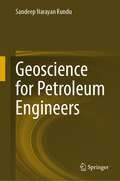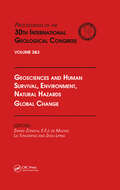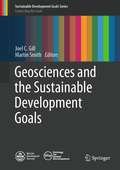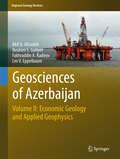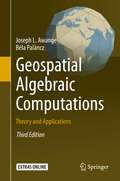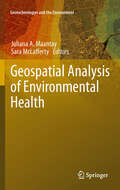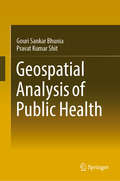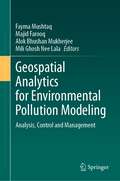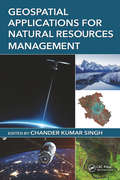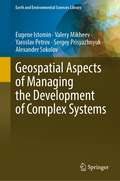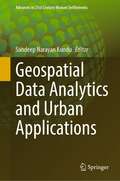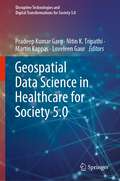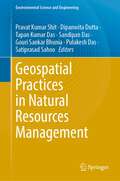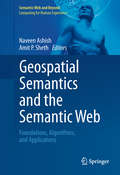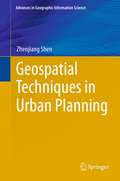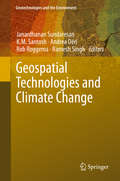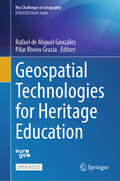- Table View
- List View
Geoscience for Petroleum Engineers
by Sandeep Narayan KunduThis book highlights the fundamental and applied aspects of geoscience that an engineer and geologist would need to be effective in the upstream petroleum industry. Geoscience is integral to exploration and production of petroleum, and a good understanding of the subject enables petroleum engineers to execute their tasks effectively in an interdisciplinary and collaborative environment. Most petroleum engineers lack a geological perspective, owing to their increased focus on core engineering disciplines, and evaluate rocks from a mechanical object. At the same time, books in geoscience which are currently available for undergraduate education are written for educating geologists only. This book aims to provide geoscience fundamentals as required by engineers and geologists to prepare for a career in the upstream petroleum industry.
Geosciences and Human Survival, Environment, Natural Hazards, Global Change: Proceedings of the 30th International Geological Congress, Volume 2 & 3
by Liu Tungsheng Zhou Liping Zhang Zhonghu E.F.J. De MulderThe proceedings of the 30th International Geological Congress held in Beijing, China in August 1997. These two volumes focuses on geosciences and human survival, environment, natural hazards and global changes. They aim to present a view of contemporary geology.
Geosciences and the Sustainable Development Goals (Sustainable Development Goals Series)
by Martin Smith Joel C. GillMeeting the targets of the UN Sustainable Development Goals (SDGs) requires contributions by scientists focusing on understanding, monitoring, protecting, managing and restoring the natural environment, including geoscientists. This book presents the first detailed discussion on the role of the geological sciences (geosciences) community in the implementation of the SDGs. Unlike traditional geosciences textbooks, it is structured according to development priorities, framed in the context of the 17 SDGs. Written by international experts from diverse range of geosciences / development disciplines, it explores themes linked to both science and the professional practice of science (e.g., ethics, equity, conduct, and partnerships). The book is intended for graduate and senior undergraduate students in the earth sciences, as well as practicing geologists and experts from other sectors involved in sustainability initiatives.
Geosciences of Azerbaijan
by Akif A. Alizadeh Ibrahim S. Guliyev Fakhraddin A. Kadirov Lev V. EppelbaumThis book provides amulti-scale and multidisciplinary perspective on the geology of Azerbaijan, acountry characterized by a unique tectonic and geological setting including theGreater and Lesser Caucasus, the Talysh Mountains, and the Caspian and KurBasins. Essential geological and geophysical data shed light on the principlesof the evolution of the Earth within the region under study, seismic activityand the distribution of economic deposits. Further, special attention is paidto the history of geological-geophysical studies in the region. A combined,comprehensive interpretation of Azerbaijan's near-surface and deep geologicalstructure is achieved on the basis of an integrative analysis of stratigraphic,magmatic, morphological, lithological, tectonic, neotectonic, geophysical andother data, combining not only Russian and Azerbaijani-published, but also whollynew geological data. Volume I addresses theneeds of researchers focused on geology and the environmental sciences, butwill also be of interest to anyone looking to learn more about the naturalphenomena in Azerbaijan, a beautiful country situated at the boundary betweenEurope and Asia.
Geosciences of the Rajasthan Basins, India (Springer Geology)
by Soumyajit Mukherjee Nihar Ranjan KarThis book provides a thorough grasp of the geology and geophysics of hydrocarbon reserves in the Rajasthan Basins, India, and the latest updates from academicians and researchers in related industrial fields. The book covers a wide variety of geological and geophysical aspects related to the Rajasthan Basins, such as hydrocarbon exploration and production methods, stratigraphy, sedimentology, paleontology, source rock characterization, and hydrocarbon potential. This book is a useful resource for a wide range of readers who are interested in geology, petroleum geology and economic geology of the basin as well as professionals in the oil and gas industry. The Rajasthan Basin in the western part of the Rajasthan state of India hosts three petroliferous sedimentary sub-basins: the Barmer, Jaisalmer and Bikaner-Nagaur sub-basins. The Barmer sub-basin has been recognized as category 1, i.e., a basin with prolific production of hydrocarbons. These three sub-basins are important for the energy security of India and are being explored and developed by major oil and gas companies. Therefore, it is important to understand the geologic structures, sedimentary depositional systems and hydrocarbon potential of the sub-basins. This study necessitates studying the stratigraphy, sedimentology, structural geology and geophysical properties of the rocks and sediments and thermal history. Such studies help to identify potential reservoirs, seals and traps for oil and gas, and to estimate the volume and quality of hydrocarbons present.
Geoscientific Research in Northeast Africa
by ULF THORWEIHE & HEINZ SCHANDELMEIERThis volume focuses on approaches towards a better understanding of the geological, hydrogeological and paleoclimatic evolution of Northeast Africa. Among the topics discussed are Phanerozoic interplate dynamics, sedimentology and stratigraphy, and mineral deposits and metallogeny.
Geospatial Algebraic Computations
by Joseph L. Awange Béla PalánczImproved geospatial instrumentation and technology such as in laser scanning has now resulted in millions of data being collected, e. g. , point clouds. It is in realization that such huge amount of data requires efficient and robust mathematical solutions that this third edition of the book extends the second edition by introducing three new chapters: Robust parameter estimation, Multiobjective optimization and Symbolic regression. Furthermore, the linear homotopy chapter is expanded to include nonlinear homotopy. These disciplines are discussed first in the theoretical part of the book before illustrating their geospatial applications in the applications chapters where numerous numerical examples are presented. The renewed electronic supplement contains these new theoretical and practical topics, with the corresponding Mathematica statements and functions supporting their computations introduced and applied. This third edition is renamed in light of these technological advancements.
Geospatial Analysis and Modelling of Urban Structure and Dynamics
by Bin Jiang Xiaobai YaoThe increasingly urbanized world has created various problems of environment, climate, consumption of resources, and public health, which are closely linked to the side-effects of urbanization such as sprawl, congestion, housing affordability and loss of open space. Fundamental to the urban problems are two separate yet related issues: urban structure and urban dynamics. The chapters collected in this book present an excellent profile of the current state of geospatial analysis and modelling, and demonstrate how these approaches can contribute to the study of various urban issues. The book addresses key themes including new ways of capturing data digitally at the individual level, the development of systems based around networks, the notion of linking hierarchy to networks to morphology as in complexity theory, and the development of new ways of integrating diverse urban processes through simulation paying careful attention to the basic econometric and statistical principles of spatial analysis. With a foreword by Michael Batty and an epilog by Michael F. Goodchild.
Geospatial Analysis of Environmental Health
by Juliana A. Maantay Sara MclaffertyThis book focuses on a range of geospatial applications for environmental health research, including environmental justice issues, environmental health disparities, air and water contamination, and infectious diseases. Environmental health research is at an exciting point in its use of geotechnologies, and many researchers are working on innovative approaches. This book is a timely scholarly contribution in updating the key concepts and applications of using GIS and other geospatial methods for environmental health research. Each chapter contains original research which utilizes a geotechnical tool (Geographic Information Systems (GIS), remote sensing, GPS, etc.) to address an environmental health problem. The book is divided into three sections organized around the following themes: issues in GIS and environmental health research; using GIS to assess environmental health impacts; and geospatial methods for environmental health. Representing diverse case studies and geospatial methods, the book is likely to be of interest to researchers, practitioners and students across the geographic and environmental health sciences. The authors are leading researchers and practitioners in the field of GIS and environmental health.
Geospatial Analysis of Public Health (Global Perspectives on Health Geography)
by Gouri Sankar Bhunia Pravat Kumar ShitThis book is specifically designed to serve the community of postgraduates and researchers in the fields of epidemiology, health GIS, medical geography, and health management. It starts with the basic concepts and role of remote sensing, GIS in Kala-azar diseases. The book gives an exhaustive coverage of Satellite data, GPS, GIS, spatial and attribute data modeling, and geospatial analysis of Kala-azar diseases. It also presents the modern trends of remote sensing and GIS in health risk assessment with an illustrated discussion on its numerous applications.
Geospatial Analytics for Environmental Pollution Modeling: Analysis, Control and Management
by Majid Farooq Fayma Mushtaq Alok Bhushan Mukherjee Mili Ghosh Nee LalaThis book aims to provide a comprehensive study on various aspects of environmental pollution dynamics using geospatial technology and modeling techniques. The utility of geospatial technology will be demonstrated for the effective study of environmental pollution, as space and location are very important for effective environmental health surveillance. The timeliness of the work is due to the increasing relevance of geospatial technology applications in environmental health investigations. Moreover, different types of pollution are covered in detail, including air and soil, all of which are analyzed using latest Remote Sensing and GIS technology. The basics of environmental pollution and its impacts are covered in the book's first part, while the second part focuses on the use of geospatial technology in investigating and modeling various instances of environmental pollution. The third part discusses policy measures for mitigating environmental pollution hazards, using geospatial analyses and data to craft informed policy decisions. The primary audience for the book is researchers working in the field of environmental pollution with incorporation of geospatial technology, including upper-level undergraduate and graduate students taking courses in remote sensing and its environmental applications. The secondary audience is academicians, planners, environmentalists and policymakers working in the field of environment protection and management.
Geospatial Applications for Natural Resources Management
by Chander Kumar SinghShelving Guide: This book will present new research regarding the interdisciplinary applications of spatial information sciences for identification, assessment, monitoring, and modeling issues related to natural resources and environmental management. It will focus on the creation, collection, storage, processing, modeling, interpretation, display and dissemination of spatio-temporal data, which could greatly aid with environmental management issues including ecosystem change, resource utilization, land use management, and environmental pollution. The positive environmental impacts of information technology advancements with regard to global environmental and climate change will also be discussed. Features Explains how geospatial information can best serve environmental management needs, including ecosystem change, resource utilization, land use management, and environmental pollution. Examines the environmental impacts of information technology advancements with regard to global environmental and climate change. Focuses on the creation, collection, storage, processing, modeling, interpretation, display and dissemination of environmental spatio-temporal data. Presents examples of applications for spatial information sciences regarding the assessment, monitoring, and modeling of natural resources. Includes practical case studies in every chapter.
Geospatial Aspects of Managing the Development of Complex Systems (Earth and Environmental Sciences Library)
by Alexander Sokolov Eugene Istomin Valery Mikheev Yaroslav Petrov Sergey PrisyazhnyukThe monograph presents the results of the development of the theoretical foundations of geoinformation management of the development of distributed organizational and technical systems and territories. The objectives of the research identified the main tasks to be solved: 1) conceptual analysis of the processes of geoinformation management of the development of spatially distributed natural and technical systems. 2) methodological foundations for managing the development of natural and technical systems. 3) methodological apparatus for providing geoinformation management for the development of natural and technical systems. 4) geoinformation systems for managing the development of natural and technical systems. 5) methods and models of decision-making risk management in managing the development of natural and technical systems. The results obtained allow, at subsequent stages of research, to develop decision-making methods based on geoinformation for real control systems of various levels and purposes, practical recommendations for improving geoinformation risk management for the development of territories and organizational and technical systems, as well as methods for measuring the parameters of distributed systems, territories and water areas.
Geospatial Challenges in the 21st Century (Key Challenges in Geography)
by Rafael de Miguel González Kostis Koutsopoulos Karl DonertThis book focuses on 21st century geospatial technologies (GT). It highlights their broad range of capabilities and their essential role in effectively addressing and resolving critical everyday issues, such as environment, sustainability, climate change, urban planning, economy, culture and geopolitics. Featuring chapters written by leading international scientists, it discusses the application of GT tools and demonstrates that the problems requiring such tools transcend national boundaries, cultures, political systems and scientific backgrounds on a global scale. In addition, it enhances readers’ spatial understanding of, and geographical reasoning in connection with, societal issues. The book will appeal to scientists, teachers and students of geography, the earth sciences and related areas, as well as decision-makers interested in the application and capabilities of geospatial technologies and new, spatial methods for addressing important issues.
Geospatial Data Analytics and Urban Applications (Advances in 21st Century Human Settlements)
by Sandeep Narayan KunduThis book highlights advanced applications of geospatial data analytics to address real-world issues in urban society. With a connected world, we are generating spatial at unprecedented rates which can be harnessed for insightful analytics which define the way we analyze past events and define the future directions. This book is an anthology of applications of spatial data and analytics performed on them for gaining insights which can be used for problem solving in an urban setting. Each chapter is contributed by spatially aware data scientists in the making who present spatial perspectives drawn on spatial big data. The book shall benefit mature researchers and student alike to discourse a variety of urban applications which display the use of machine learning algorithms on spatial big data for real-world problem solving.
Geospatial Data Science in Healthcare for Society 5.0 (Disruptive Technologies and Digital Transformations for Society 5.0)
by Martin Kappas Loveleen Gaur Pradeep Kumar Garg Nitin K. TripathiThe book introduces a variety of latest techniques designed to represent, enhance, and empower multi-disciplinary approaches of geographic information system (GIS), artificial intelligence (AI), deep learning (DL), machine learning, and cloud computing research in healthcare. It provides a unique compendium of the current and emerging use of geospatial data for healthcare and reflects the diversity, complexity, and depth and breadth of this multi-disciplinary area. This book addresses various aspects of how smart healthcare devices can be used to detect and analyze diseases. Further, it describes various tools and techniques to evaluate the efficacy, suitability, and efficiency of geospatial data for health-related applications. It features illustrative case studies, including future applications and healthcare challenges. This book is beneficial for computer science and engineering students and researchers, medical professionals, and anyone interested in using geospatial data in healthcare. It is also intended for experts, offering them a valuable retrospective and a global vision for the future, as well as for non-experts who are curious to learn about this important subject. The book presents an effort to draw how we can build health-related applications using geospatial big data and their subsequent analysis.
Geospatial Practices in Natural Resources Management (Environmental Science and Engineering)
by Tapan Kumar Das Gouri Sankar Bhunia Pravat Kumar Shit Pulakesh Das Dipanwita Dutta Sandipan Das Satiprasad SahooThis book provides a multidisciplinary synthesis of the sustainable management of natural resources. The book presents applicable knowledge of land, water, and forest resources along with in-depth investigations of multiple management pathways. This book also demonstrated the contemporary applications of geospatial technology in data mining techniques, data analysis, modeling, assessment, and visualization, and appropriate management strategies in different aspects of natural resources. The book explores the latest state-of-the-art techniques using open-source software, statistical programming, and modeling platforms, including artificial intelligence techniques in natural resource management. It is a valuable resource for students, researchers, and practitioners in geography, geospatial sciences, and environmental sciences, especially those interested in land, water, and forest resources.
Geospatial Semantics and the Semantic Web
by Naveen Ashish Amit P. ShethThe availability of geographic and geospatial information and services, especially on the open Web has become abundant in the last several years with the proliferation of online maps, geo-coding services, geospatial Web services and geospatially enabled applications. The need for geospatial reasoning has significantly increased in many everyday applications including personal digital assistants, Web search applications, local aware mobile services, specialized systems for emergency response, medical triaging, intelligence analysis and more. Geospatial Semantics and the Semantic Web: Foundations, Algorithms, and Applications, an edited volume contributed by world class leaders in this field, provides recent research in the theme of geospatial semantics. This edited volume presents new information systems applications that have potential for high impact and commercialization. Also, special effort was made by the contributors to focus on geospatial ontology development, related standards, geospatial ontology alignment and integration, and algorithmic techniques for geospatial semantics. Case studies and examples will be provided throughout this book as well as possibilities for future research.
Geospatial Techniques in Urban Hazard and Disaster Analysis
by Pamela S. Showalter Yongmei LuThis book examines how Geographic Information Technologies (GIT) are being implemented to improve our understanding of a variety of hazard and disaster situations. The volume is a compilation of recent research using Geographic Information Systems (GIS), Remote Sensing (RS) and other technologies such as Global Positioning Systems (GPS) to examine urban hazard and disaster issues. The goal is to improve and advance the use of such technologies during four classic phases of hazard and disaster research: response, recovery, preparation and mitigation. The focus is on urban areas, broadly defined in order to encompass rapidly growing and densely populated areas. The material presented is multidisciplinary, with contributions from scholars in Africa, Asia, Europe, Latin America and North America, and is presented in five key sections: sea level rise and flood analysis earthquakes and tsunamis and international applications hurricane response/recovery metropolitan case studies evacuation studies This volume contributes to our understanding of extreme events in urban environments with the use of GIT and expanding its role at the local, regional, state and federal levels. The book is a valuable reference for academic researchers and professionals and practitioners working in hazard management and mitigation.
Geospatial Techniques in Urban Planning
by Zhenjiang ShenThis work presents cases studies of applications of Geotechnology such as Geography Information Systems, virtual reality and cellular automaton and multi-agent systems in the field of urban planning and design.These are joint research presentations with students and colleagues from Kanazawa University. All these case studies are about application in Japanese or Chinese cities, which are on-field examples reflecting the enormous spread of geo-computation technology. Nevertheless, the concepts have wide applicability to other contexts. The works can be classified into three types of Geotechnological applications at different levels of urban spaces, which are relevant to different kinds of urban planning and development projects. The book is comprised of three parts: Part 1: Geosimulation and land use plan Part 2: Geo Visualization and urban design Part 3: Geography information system and planning support
Geospatial Technologies and Climate Change
by Rob Roggema Ramesh Singh Janardhanan Sundaresan K M Santosh Andrea DériGeospatial Technologies and Climate Change describes various approaches from different countries on how to use geospatial technologies to help solving climate change issues. It also details how different geospatial technologies (remote sensing, Geographical Information System. . . ) can be used to help with climate monitoring and modeling, how to work with them and what to be careful about. This book is written by scientific experts from four different continents. Written in a comprehensive and complete way, this book is essential reading material for graduate and undergraduate students interested in these techniques and in climate change.
Geospatial Technologies for Agriculture: Case Studies from India (SpringerBriefs in Environmental Science)
by K. V. Raju V. R. Hegde Satish A. HegdeThis book uniquely presents accurate and up-to-date information related to crops in small and fragmented agricultural lands with mixed cropping patterns. The book involves research using remote sensing (RS), Global Positioning Systems (GPS) and Geographic Information Systems (GIS) to develop crop inventories in three growing seasons in three villages across India to inform decision makers and planners on best practices for agricultural management. The data analysis of crop details using various geospatial technologies fills in gaps in statistical agriculture research, and provides reliable, replicable and efficient methods for generating agricultural statistics. The book will be of interest to statisticians, planners and decision makers in crop management and production.
Geospatial Technologies for All: Selected Papers Of The 21st Agile Conference On Geographic Information Science (Lecture Notes in Geoinformation and Cartography)
by Ron Van Lammeren Ali Mansourian Petter Pilesjö Lars HarrieThis book presents the research papers accepted for the 21st AGILE Conference on Geographic Information Science, held at Lund University Geographical Information Systems (GIS) Centre, Sweden on 12–15 June 2018. It discusses the role of geospatial technologies in the digitalization of society and is intended primarily for professionals and researchers in fields that can benefit from geoinformation – both within and outside the area of geographic information science.
Geospatial Technologies for Crops and Soils
by Ram Swaroop Meena Tarik Mitran Abhishek ChakrabortyThe sustainable development of the agriculture sector is the only option to meet the demands of increased and economically viable production in a changing climate. This means there is a need to introduce the latest technologies to enhance production, and also help policymakers make decisions for the future. Geospatial technologies & tools, such as remote sensing, geographical information systems (GIS), global positioning systems (GPS), and mobile & web applications, provide unique capabilities to analyze multi-scale, multi-temporal datasets, and support decision-making in sustainable agriculture development and natural resources management. Further, the availability of reliable and timely geospatial information on natural resources and environmental conditions is essential for sustainable agricultural development and food security. Since remote sensing solutions are fast, non-destructive and have large spatial coverage, they can play a significant role in the identification, inventory, and mapping of land resources. Over the past four decades, remote sensing has proved to be a cost-effective and powerful tool to assess crop and soil properties in varying spatial and temporal scales using both visual and digital techniques. Satellite remote sensing coupled with GIS & mobile-app based positional information has emerged as an efficient tool for optimizing input resources, and minimizing cost of production and risk of biotic/ abiotic factors nature to promote sustainable agriculture. This book comprehensively documents the applications of space-based technologies for crop and soil assessments for the sustainable development of agriculture.
Geospatial Technologies for Heritage Education (Key Challenges in Geography)
by Rafael de Miguel González Pilar Rivero GraciaThis open access book shows that students, through geospatial technologies, learn the sustainable approach of heritage and also the heritage as a diversity of elements due to the complexity of physical, human, cultural, and artistic factors involved. The value of natural and cultural heritage, as part of collective heritage, can be acquired by geographic information systems (GIS) due to the multilayer approach of the spatial configuration. Proficiency in geospatial technologies to collect, process, analyze, interpret, visualize, and communicate geographic information is being increased by undergraduate and graduate students but, in particular, by those who are training to become geography, history, and art history teachers at the primary and secondary education levels. Some teaching experiences, using personalized learning, distance learning methodology, and GIS, focused on education aims to integrate students and enhance their understanding of the heritage are welcome. Opportunities offered by WebGIS in heritage education to learning research and teacher education research also fit with the scope of this book.
